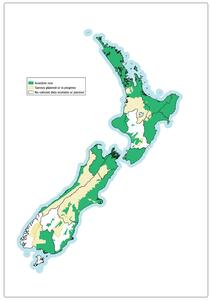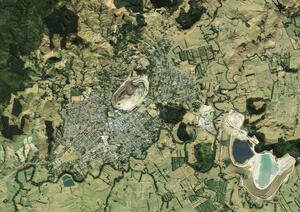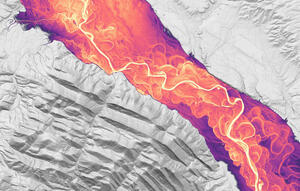More than half of New Zealand can now be freely viewed in astounding detail following the release of three-dimensional mapping data for Waikato and Southland.
Accessed for free via the Toitū Te Whenua LINZ Data Service, the latest release is part of a project that will ultimately provide detailed 3D imagery for 80 percent of the country.
“There is great demand for the data by local government, private sector companies, academia and Crown Research Institutes, and this demand continues to grow as the national coverage expands,” says Bjorn Johns, Toitū Te Whenua Technical Leader Imagery and Elevation.

National LiDAR coverage as at 30 July 2023.
LiDAR (light detection and ranging) technology is being used to capture high-definition data about the shape of the land.
LiDAR uses light in the form of a pulsed laser to measure ranges (variable distances) to the Earth. These light pulses—combined with other data — generate precise, three-dimensional maps, also known as digital elevation models.
“These are invaluable to councils and regional industries for planning and will help with land management, flood and landslide hazard mapping, engineering design and 3D visualisation,” says Mr Johns.
“Having baseline data will make it easier to assess changes resulting from major events like earthquakes and severe weather events. Areas can be resurveyed and the new images compared with base data to better understand the impact of the events and to support the response and recovery phases of an emergency.”

A view of Waihi showing the Waihi Mine with LiDAR adding depth to aerial photography.
The release of LiDAR data for Waikato and Southland adds to data already collected and released through a project co-funded by regional councils and Kānoa, the Regional Development and Investment Unit within the Ministry of Business, Innovation and Employment (formerly the Provincial Growth Fund). The project began in 2018 and is due to be completed in 2024.
Toitū Te Whenua Manager Partnership Programmes Andrew Ferrel says there is a real sense of satisfaction, not just in reaching the 50 percent milestone but in seeing how the data is being used.
“Making this data available supports innovation and gives all businesses and other operators access to detailed information that would otherwise be unavailable to many.”
Co-funding from Kānoa - RDU is supporting the substantial regional expansion of the New Zealand National Elevation Programme, which is based on partnerships between Toitū Te Whenua and councils across all 16 New Zealand regions.
Location Data Analyst Emory Beck is working on quality control of the new data: “Having early access to data covering parts of the country at this level of detail is fascinating as we see the many different types of landforms and relief features that are ‘unearthed’ by elevation data.”
Data gathered by Toitū Te Whenua and councils through the PGF-LiDAR programme is available to everyone.
Find out more on the Elevation Aotearoa website.

3D image of Mataura River, Southland’s longest awa.
Media contact
Email: media@linz.govt.nz